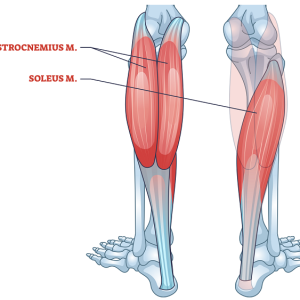Overview
The Standing Calf Raise on the Bench Press Machine is an isolation strength training exercise targeting the gastrocnemius muscles of the calves. By using a fixed machine setup, this movement allows for a controlled, safe environment to progressively load the calves with significant resistance. It is suitable for hypertrophy, endurance, or general strength development in lower legs.
This technique is commonly used when traditional standing calf raise machines are unavailable or when one prefers a customized platform setup with free motion control.
How to Perform:

Setup: Step onto the machine’s platform with the balls of your feet firmly on the edge and your heels hanging off.
Position: Stand upright and grip the side handles for balance and stability.
Starting Position: Keep your core engaged, back straight, and legs nearly straight (but not locked out).
Raise Your Heels: Press through the balls of your feet to lift your heels as high as possible. Focus on contracting your calves at the top.
Pause and Squeeze: Hold the top position for 1–2 seconds to maximize muscle engagement.
Lower Under Control: Slowly lower your heels below the level of the platform for a full stretch before repeating.
Tips for Proper Form
Keep your core tight to maintain upright posture and avoid arching the lower back.
Avoid locking your knees — a slight bend keeps the tension on the calves.
Use a full range of motion, lowering your heels fully and rising onto your toes completely.
Control the descent; do not drop your heels quickly.
Focus on mind-muscle connection, especially during the pause at the top.
Common Mistakes
Using momentum: Bouncing up and down reduces muscle activation and increases injury risk.
Partial range of motion: Not fully raising or lowering your heels limits stretch and contraction.
Locked knees: This shifts tension away from the calves and may stress the joints.
Rushing reps: Fast, uncontrolled movements minimize muscle time under tension.
Leaning forward: Reduces effectiveness and places unnecessary strain on the back.
Benefits:
Builds calf muscle mass: Targets the gastrocnemius for increased size and definition in the calves.
Improves ankle strength: Strengthens ankle joints and supporting tendons, reducing injury risk during running and jumping.
Enhances balance and posture: Strong calves contribute to better upright alignment and gait mechanics.
Supports athletic performance: Essential for sprinters, jumpers, and field athletes who rely on explosive lower-leg power.
Increases range of motion in ankles: Promotes flexibility and functional mobility in the ankle joint.
Accessible and adaptable: Can be performed using any bench press machine or Smith machine with minimal equipment adjustments.
Supports tendon health: Strengthens Achilles tendon and plantar fascia when performed with proper form and volume.
How to Incorporate Into Your Routine
- For Beginners: Start with 2–3 sets of 10–12 reps using moderate machine resistance. Focus on perfect form and full range of motion.
- For Hypertrophy: Perform 3–4 sets of 12–15 reps with controlled tempo and full peak contraction to maximize calf growth.
- For Strength: Use 4–5 sets of 6–8 reps with heavier weight, pausing at the top for 1–2 seconds to build ankle joint strength.
- For Endurance: Perform 3 sets of 20+ reps using body weight or light resistance for muscular endurance and stamina.
- For Athletic Training: Superset with jumping or sprint drills to develop explosive ankle power and foot control.
- For Bodybuilding: Include in lower-body day as an accessory lift to shape and define the calves.
Muscles Worked

Frequently Asked Questions
Can I do standing calf raises on any bench press machine?
Yes, as long as the machine allows for barbell racking and there is a stable platform for foot elevation.
How often should I train calves for size?
2–3 times per week with progressive overload is effective for calf hypertrophy.
What if I feel it more in my quads or lower back?
Check your posture and ensure you are not leaning forward or overextending your spine.
Should I use shoes or go barefoot?
Flat shoes or barefoot can enhance foot stability and ground contact, but make sure your platform has grip.
Is it normal to feel a burn during high reps?
Yes, the calves have high endurance fiber composition, and burning is common during longer sets.
